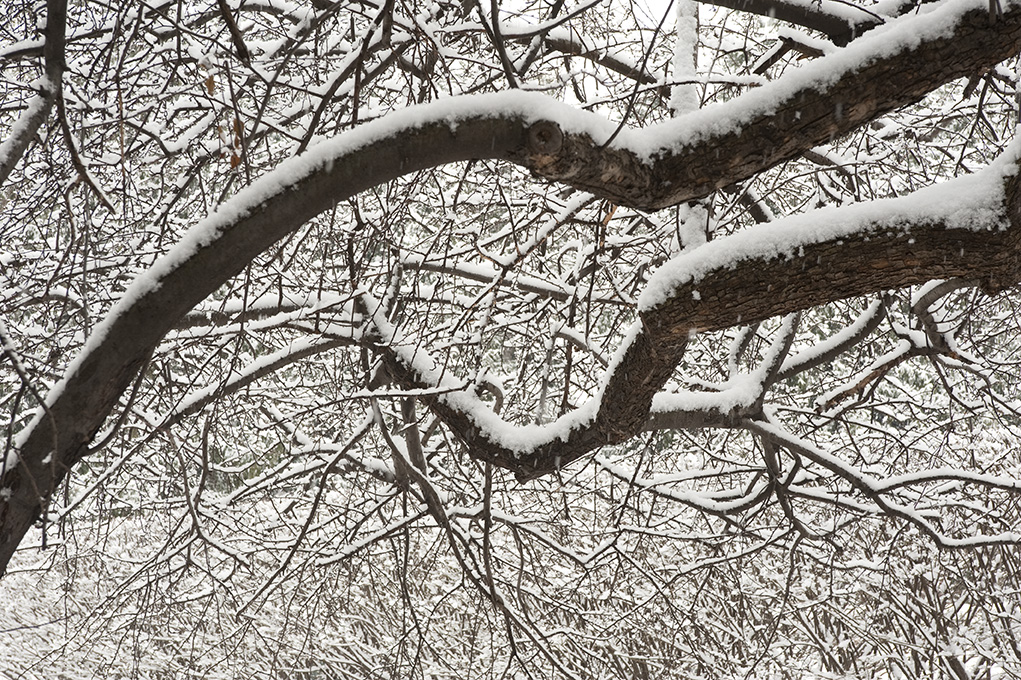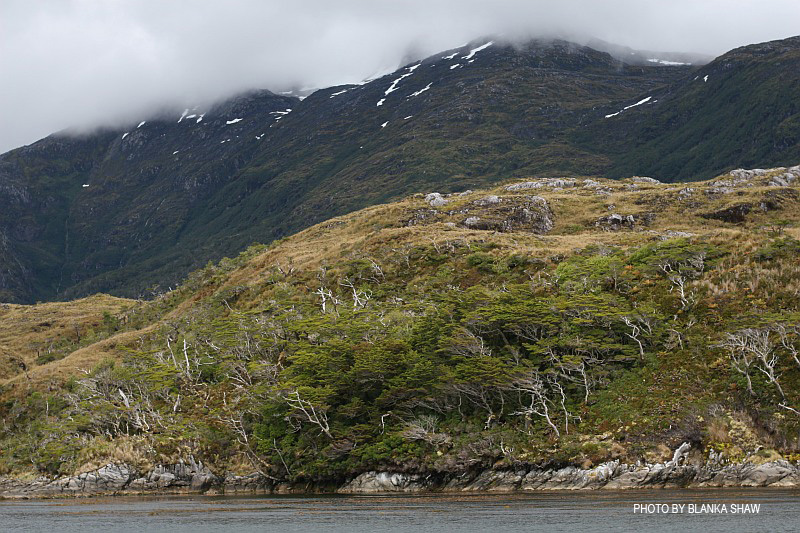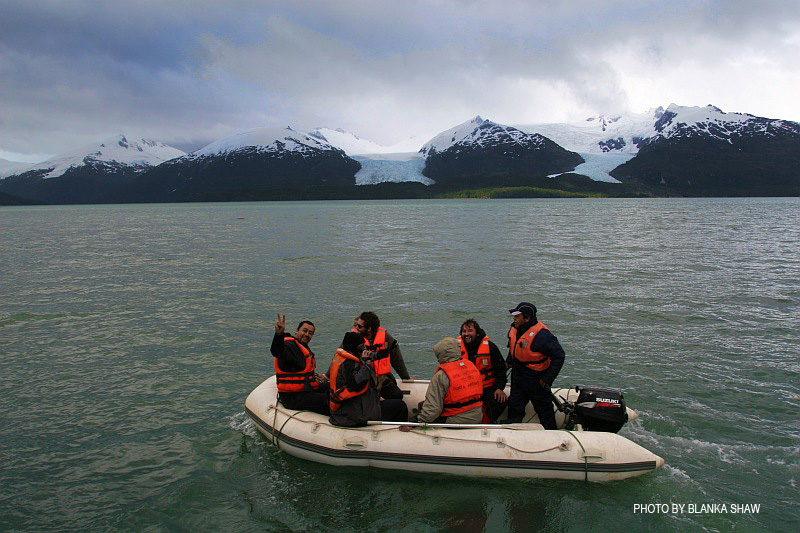Morning Eye Candy: Under the Boughs
Posted in Photography on January 28 2011, by Plant Talk
Abstraction on the Seasonal Border.

(photo by Ivo M. Vermeulen)

Inside The New York Botanical Garden
Posted in Photography on January 28 2011, by Plant Talk
Abstraction on the Seasonal Border.

(photo by Ivo M. Vermeulen)
Posted in Bill Buck, From the Field, Science on January 27 2011, by William R. Buck
Ed. note: NYBG scientist and Mary Flagler Cary Curator of Botany, Bill Buck is currently on expedition to the islands off Cape Horn, the southernmost point in South America, to study mosses and lichens. Follow his journeys on Plant Talk.
 January 22, 2011, Isla Grande de la Tierra del Fuego, Seno Brujo,, Chile, 54° 30’S, 71° 32’W
January 22, 2011, Isla Grande de la Tierra del Fuego, Seno Brujo,, Chile, 54° 30’S, 71° 32’W
Yes, we’re in the same place as yesterday. The captain of our ship said that last night, winds of 80 knots (88 mph) were expected, and so he did not want to take the ship out into open water. 88 mph!! That’s hurricane force winds, and indeed during the night the winds howled and the ship was buffeted about.
I got up in the night and went out onto the deck at 3:45 a.m. The deck was illuminated with moonlight, many stars were visible, and the snow glowed on nearby mountains; however, the wind was strong and I held onto the railing to make sure I wouldn’t be blown overboard. Moments like this, alone in the glory of nature, are the moments I treasure above almost everything else. When I came out again at 6:15 a.m., the sun had risen, the winds had died down and the sky was mostly clear. If nothing else, the weather here can change quickly.
By the time we were ready to go into the field, it had started to rain again, but this time only lightly, and the winds, and thus the sea, remained calm. We headed toward what we initially thought was a lake but instead turned out to be a shallow inlet of the sea, accessible by zodiac. We split up and Jim headed toward a large, glacier-fed waterfall because of his special interest in rheophytic bryophytes, those that grow on rocks in moving water. Some rheophytes are only in the water seasonally, following rain patterns, and others are permanently wet. Juan headed up the mountain, toward the snow, because the moss genus he is working on for his dissertation often grows on exposed rocks. Blanka collected along the shore of the small inlet, and I headed for the rocky peaks near the shore and the pockets of forest in more sheltered sites.
Posted in Photography on January 27 2011, by Plant Talk
No, we’re not bioengineering treat-dispensing shrubbery. It’s just snowing a lot this winter, coating everything in what, on some days, looks like a thick layer of Marshmallow Fluff.
Snowy Shrubbery (photo by Ivo M. Vermeulen).
Posted in Bill Buck, From the Field, Science on January 26 2011, by William R. Buck
Ed. note: NYBG scientist and Mary Flagler Cary Curator of Botany, Bill Buck is currently on expedition to the islands off Cape Horn, the southernmost point in South America, to study mosses and lichens. Follow his journeys on Plant Talk.
 January 21, 2011, Isla Grande de la Tierra del Fuego, Seno Brujo, Chile, 54° 30’S, 71° 32’W
January 21, 2011, Isla Grande de la Tierra del Fuego, Seno Brujo, Chile, 54° 30’S, 71° 32’W
The weather caught up with us today. I’ve hardly mentioned the weather, up to this point, because it is such a part of the region that it’s easy to take it for granted. Prior to the trip I warned everyone to be prepared for temperatures around 50ºF, 40 mph winds, and rain. Until today we had been lucky. By that I mean, it has been cool, and somewhat windy, but with only occasional light rain. Here, this is considered good summer weather! Yesterday, our first full collecting day, the weather was cool and breezy with intermittent light rain. Last night when we were discussing the day among ourselves, some of our group hadn’t even noticed that it had rained at all, and it probably rained about a third of the time in the morning. But it was only a light rain and the vegetation is permanently wet, so a little more water was easy to overlook.
Early this morning we left Seno Bluff for the next sound to the west, Seno Sargazos. It was calm waters and overcast but not raining. Right after breakfast we went ashore and collected for several hours along a lake-fed river. I asked the Chileans what they would call the vegetation and was told it was called Magellanic tundra. What a good name! There were only patches of trees in small ravines, the landscape mostly consisted of tussocks of herbaceous plants and bryophytes about 2 feet tall that are very spongy underfoot, with holes between the tussocks. Walking was slow and treacherous. However, collecting was good and we found some real sub-Antarctic mosses.
During lunch we moved the ship to the next sound west, Seno Brujo. Our goal was to get to the southernmost end of it and then work up a river to a large lake we could seen on a map. I guess the rough seas between the two sounds should have been an indication that the weather was changing. When we arrived it was raining hard, but wasn’t too windy, and we decided to go collecting at least for a couple of hours. However, as we suited up in our rain gear, the weather worsened. Once we were standing out on the deck, ready to board the zodiac to go ashore, the rain became torrential and the wind picked up, driving the rain almost horizontally. When it hit your skin it felt like sleet because of the force as well as how cold it was.
The waters were rough with white tops being driven up by the wind. I made an executive decision that we would not go out in the afternoon, much to everyone’s relief. So, we’ll spend the night here tonight, in a slightly more sheltered cove, and go out in the morning. In this part of the world the weather is always a factor, but it is this very weather that results in such lush bryophytes. It is also the reason why the area is uninhabited and the landscape is so stunningly spectacular. But that can wait for morning!
Bill Buck’s Previous Reports From the Field
January 20, 2011, Isla Grande de la Tierra del Fuego, Seno Bluff, Chile
Posted in Photography on January 26 2011, by Plant Talk
It just keeps snowing here at the Garden. And it just keeps getting prettier, too.
Winter in the Bruckman Crabapple Collection (photo by Ivo M. Vermeulen)
Posted in Wildlife on January 25 2011, by Plant Talk
| Chris Nagy is a Ph.D. student at CUNY, and a wildlife biologist at the Mianus River Gorge Preserve in Bedford, N.Y. |
 In December I had the opportunity to survey The New York Botanical Garden for Eastern Screech-Owls. I have been chasing Eastern Screech-Owls in the Bronx and Manhattan for nearly 7 years, as part of my Ph.D. research, and getting the chance to look for them in the Garden was a treat.
In December I had the opportunity to survey The New York Botanical Garden for Eastern Screech-Owls. I have been chasing Eastern Screech-Owls in the Bronx and Manhattan for nearly 7 years, as part of my Ph.D. research, and getting the chance to look for them in the Garden was a treat.
The easiest way to look for owls, if you’re willing to wander through the woods at night, is to play recordings of their vocalizations. Most owls communicate primarily through calls, and if there’s an owl nearby, it will probably call back when it hears your broadcast.
There have been no reports of Screech-Owls at the Garden for many years, and we didn’t find any this time either. (Ed. note – Though we have no Eastern Screech-Owls, the Garden is home to at least one Northern Saw-Whet Owl and a family of Great Horned Owls). But determining the places where owls are not is just as important as finding where they are.
By comparing the geographic location, habitat characteristics, and other variables in places where they are found versus where they are not, we can determine what features are important for a species. My hunch is that the absence of Eastern Screech-Owls at the Botanical Garden has more to do with the Garden’s location within the larger city than with any specific habitat quality. Alternatively, there also may be larger raptors at the Garden discouraging the smaller Screech Owls from readily calling back, or from making the Garden their home at all.
I’d like to thank NYBG staff, especially Jessica Arcate Schuler, for their help and allowing me to perform some of my research at the Garden.
Posted in Photography on January 25 2011, by Plant Talk
Four-season gardening can be as simple as ensuring your garden has something that will provide winter interest, like this wonderful hedge, Euonymus alatus ‘Compactus’ (commonly known as Dwarf Winged Euonymus or Dwarf Burning Bush) in the Seasonal Border.
We’ve Got Rhythm (Photo by Ivo M. Vermeulen)
Posted in Photography on January 24 2011, by Plant Talk
Squirrels. They have so much attitude. Where does it come from?
Squirrel! (photo by Ivo M. Vermeulen)
Posted in Photography on January 23 2011, by Plant Talk
”The time has come,” the Walrus said,
”To talk of many things:
Of shoes–and ships–and sealing-wax–
Of cabbages–and kings–
And why the sea is boiling hot–
And whether pigs have wings.”
Lewis Carroll – The Walrus and the Carpenter
Cyrtostachys renda Sealing Wax Palm (photo by Ivo M. Vermeulen)
Posted in Photography on January 22 2011, by Plant Talk
A popular common name for this flower is “Powderpuff.” Very little explanation needed as to why!
Calliandra emarginata (photo by Ivo M. Vermeulen)